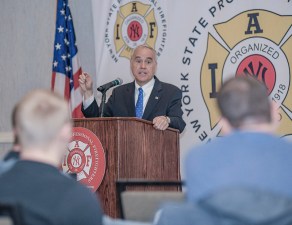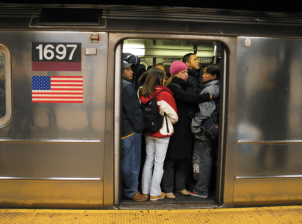DiNapoli: If Cuomo Borrows More for the MTA, Get Ready for Fat Fare Hikes
Without a commitment from the state to close the $15.2 billion gap in the MTA’s capital program, the cost of a MetroCard is likely to spike as the MTA adds to its cumbersome debt load, according to a new report from Comptroller Tom DiNapoli [PDF]. The warning comes as Governor Andrew Cuomo and the legislature begin the very early stages of negotiations over funding the capital plan, which maintains, upgrades, and expands the transit system.

By some measures, the MTA is doing well: Ridership is reaching new highs, the authority is making progress on cost savings, and an improving economy has buoyed its finances. But there’s trouble around the corner: Labor and health care expenses are already rising faster than the MTA can pay for them even as new labor deals pile on more costs, federal funding is questionable, debt is at record levels, and the next capital plan is only halfway funded. Without new sources of revenue, issuing more debt to pay for system upkeep and expansion will translate into more fare hikes.
The authority is already planning on issuing $6.2 billion in debt for the next capital plan. Even with that borrowing, there’s still a $15.2 billion gap. Without action in Albany to bring in new revenue, the MTA will likely do what it did last time: Cut the capital program while issuing even more debt. That means fare hikes.
Fares are already scheduled to increase faster than inflation, with back-to-back four percent hikes scheduled for 2015 and 2017. If the MTA has to issue more debt to pay for the capital program, DiNapoli calculates that riders should expect an additional 1 percent hike for every $1 billion borrowed.
MTA debt is already set to exceed $39 billion by 2018, according to DiNapoli, more than double the amount in 2003. Servicing that debt consumes an ever-greater share of the MTA’s operating budget, which is already squeezed by rising labor and health care costs. Who pays? Transit riders, who have to deal with higher fares and suboptimal service, as the agency spends more on interest payments and less on running trains and buses.
Adding more debt could also threaten the authority’s bond rating and ability to borrow down the road. Avoiding that scenario would likely require new revenue sources. Transit advocates are backing the Move New York plan, which adds tolls to crossings into the Manhattan business district while reducing them on outlying bridges. While the de Blasio administration hasn’t ruled it out, Cuomo has been far cooler to the idea.
Yesterday, Cuomo offered a glimmer of hope. “I think everything is on the table, from my point of view. And that’s where the conversation should start, with all options,” he told Capital New York. MTA Chairman and CEO Tom Prendergast, a Cuomo appointee, has urged the creation of new funding sources instead of an increasing reliance on debt. Can Cuomo actually lead on transit? We’ll see in the months ahead.

